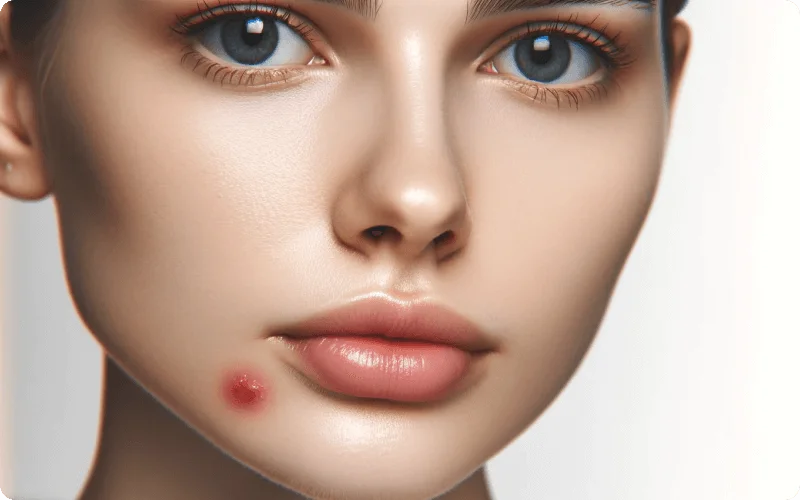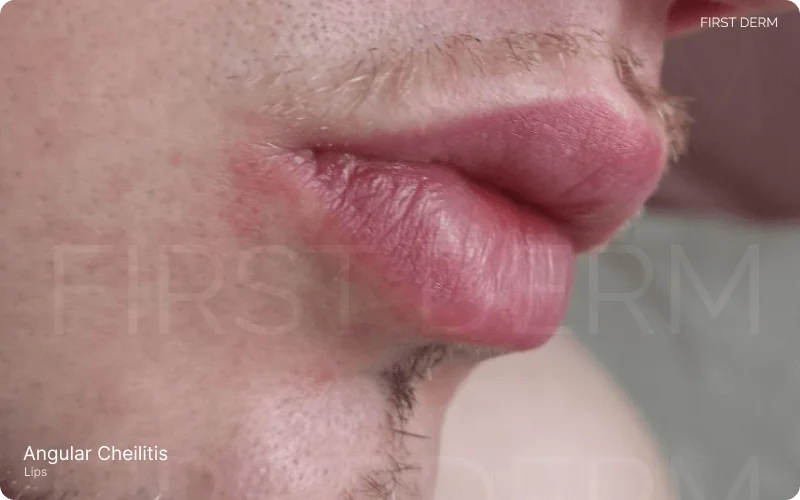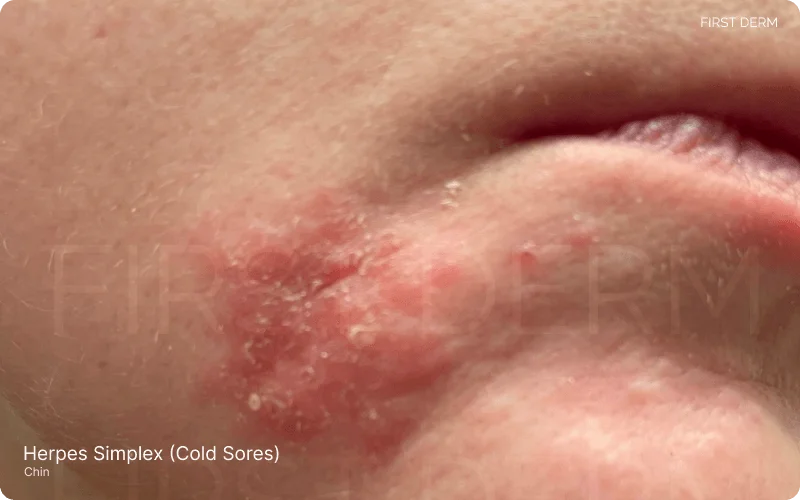Angular Cheilitis vs. Cold Sores: What’s the Difference?

Key Takeaways
-
Distinct Conditions: Angular cheilitis and cold sores are separate conditions with different causes. Angular cheilitis arises from factors like fungal or bacterial infections and nutritional deficiencies, while cold sores are caused by the herpes simplex virus.
-
Symptoms and Locations: Angular cheilitis typically manifests as sores at the corners of the mouth, whereas cold sores appear as blisters around the lips or face.
-
Contagiousness: Cold sores are contagious, as they are caused by a virus. In contrast, angular cheilitis is generally not contagious.
-
Treatment Approaches: Treatment for angular cheilitis may involve addressing the underlying causes (such as infections or nutritional deficiencies), while cold sores are treated with antiviral medications and supportive care.
-
Prevention and Oral Hygiene: Preventive measures include avoiding triggers specific to each condition and maintaining good oral hygiene to manage symptoms and prevent the spread, particularly of contagious cold sores.
Angular cheilitis and cold sores are two distinct conditions that are often confused due to their similar clinical presentation. Angular cheilitis is characterized by painful sores at the corners of the mouth, while cold sores are small, painful blisters that can appear anywhere around the lips or face.
The purpose of this article is to distinguish between these two conditions, focusing on their characteristics, causes, and treatment. Angular cheilitis is not contagious and is often caused by factors such as fungal infections, excess skin around the mouth, or inflammatory conditions. On the other hand, cold sores are caused by the herpes simplex virus and are contagious.
What is Angular Cheilitis?

Red irritated skin at the corners of the mouth indicating symptoms of Angular Cheilitis, characterized by dryness, cracking, redness, and irritation in the affected area
Angular cheilitis is a common, non-contagious, inflammatory condition affecting the corners of the mouth or oral commissures. It presents with classic features of red, edematous, often painful patches of skin at the labial commissures, which are roughly triangular lesions.[1]
The condition may start with pinkish erythema and progress to moisture-induced maceration, leading to small, gray-white lesions bordered by reddened mucosa. As the condition advances, the skin may become papular, eczematous, and fissured. These symptoms can cause discomfort and can be exacerbated by activities such as eating, talking, or opening the mouth wide. Angular cheilitis is also known as angular stomatitis, cheilosis, rhagades, or perleche.[2]
It can be caused by various factors, including fungal or bacterial infections, nutritional deficiencies, and other contributing factors.Risk factors for angular cheilitis include dry, chapped lips, oral thrush, ill-fitted dentures, poor nutrition (e.g., iron deficiency, riboflavin deficiency, general protein deficiency), and certain medical conditions like diabetes. The condition is usually not serious, but severe cases can result in scarring or thin skin.
What is Cold Sores (Herpes Simplex Labialis)?

Cold Sore on Chin: Current State of a Dry, Scaly Patch with a History of Redness and Irritation, Following a Pimple – A Typical Herpes Simplex Virus Manifestation
Cold sores are caused by the herpes simplex virus (HSV), which is estimated to have infected 67% of the world’s population under the age of fifty, according to a report by the World Health Organization.[3] Once you have the virus, it stays in your body for the rest of your life, and outbreaks can occur periodically. Cold sores usually appear as small, painful blisters on or around the lips, but they can also occur on the nose, cheeks, or inside the mouth.
The virus is highly contagious and can be spread through close contact, such as kissing, sharing utensils or towels, or oral sex.The virus can also be spread even when there are no visible symptoms. The symptoms of cold sores typically include a tingling or burning sensation on the affected area, followed by the appearance of small, fluid-filled blisters. The blisters can be painful and may break open, oozing fluid and forming a crust before healing.
Other symptoms may include fever, swollen lymph nodes, and muscle aches.Cold sores can be triggered by various factors, including stress, illness, hormonal changes, exposure to sunlight, and a weakened immune system.There is no cure for cold sores, but antiviral medications can help reduce the severity and duration of outbreaks.[4]
Angular Cheilitis vs. Cold Sores: Symptom Comparison
Understanding the distinctions between Angular Cheilitis and Cold Sores is crucial for accurate diagnosis and effective management.
| Symptom | Angular Cheilitis | Cold Sores |
| Location | Corners of the mouth, often bilateral | Typically on or around the lips |
| Appearance | Redness, fissures, and cracking at corners | Fluid-filled blisters or sores |
| Pain | Often associated with discomfort and pain | Tenderness, tingling, and pain during outbreaks |
| Swelling | Swelling may occur due to inflammation | Blisters can cause noticeable swelling |
| Crusting | Common, with dried crusts forming at corners | Blisters may crust over as they heal |
| Causes | Candida yeast, bacterial infection, or both | Herpes simplex virus (HSV) |
| Onset | Gradual development of symptoms | Sudden onset during HSV activation |
| Triggers | Prolonged moisture, nutritional deficiencies | Stress, fever, sun exposure, weakened immunity |
| Contagiousness | Generally not contagious | Highly contagious during active outbreaks |
| Recurrence | May recur if underlying causes aren’t addressed | Frequently recurring, especially with HSV-1 |
- Angular Cheilitis primarily affects the corners of the mouth, often spreading bilaterally. On the other hand, Cold Sores manifest on or around the lips, creating a distinctive pattern.[5]
- The visual aspects of these conditions differ significantly. Angular Cheilitis presents with redness, fissures, and cracking at the mouth corners, while Cold Sores are characterized by fluid-filled blisters or sores, often progressing through stages of blistering and crusting.
- Angular Cheilitis typically has a gradual onset with symptoms developing over time. In contrast, Cold Sores exhibit a sudden onset during the activation of the herpes simplex virus (HSV).
- Angular Cheilitis is generally not considered contagious, whereas Cold Sores, especially during active outbreaks, are highly contagious due to the presence of the herpes simplex virus.[6]
Angular Cheilitis vs. Cold Sores: Causes and Risk Factors
| Causes and Risk Factors | Angular Cheilitis | Cold Sores |
| 1. Fungal Infections | Candida overgrowth in the corners of the mouth | Not applicable (HSV-1 infection is viral, not fungal) |
| 2. Bacterial Infections | Infections from bacteria such as Staphylococcus aureus or Streptococcus species | Not applicable (HSV-1 infection is viral, not bacterial) |
| 3. Nutritional Deficiencies | Iron, vitamin B (B2, B3, B6, B12), or protein deficiencies | Not directly associated; HSV-1 infection is the primary cause |
| 4. Chronic Conditions | Inflammatory bowel disease (IBD), diabetes | Not directly associated; HSV-1 infection is the primary cause |
| 5. Immune System Illnesses | HIV infection | Weakened immune system increases susceptibility to HSV outbreaks |
| 6. Smoking | Yes | Not directly associated, but smoking may affect immune response |
| 7. Dental Factors | Losing teeth, ill-fitting dentures | Not directly associated; HSV-1 infection is the primary cause |
| 8. Excess Moisture | Moisture on the lips or mouth | Not directly associated; HSV-1 infection is the primary cause |
| 9. Medications | Certain medications like paroxetine (Paxil), tetracyclines, metronidazole (Flagyl) | Not directly associated; HSV-1 infection is the primary cause |
| 10. Thumb Sucking | Yes | Not directly associated; HSV-1 infection is the primary cause |
| 11. Xerostomia (Dry Mouth) | Dry mouth | Not directly associated; HSV-1 infection is the primary cause |
- The main causes of angular cheilitis include fungal infections, such as Candida, and bacterial infections, which account for about 20% of cases.[7] Additionally, nutritional deficiencies, especially of iron and B vitamins, are important in the development of angular cheilitis. Other contributing factors may involve chronic conditions like inflammatory bowel disease or diabetes, immune system illnesses like HIV, smoking, ill-fitting dentures, excess moisture on the lips or mouth, certain medications, thumb sucking, and dry mouth. The condition is also more likely to occur in individuals with poor health, such as those with coeliac disease, zinc deficiency, or vitamin B12 and/or folate deficiency.
- The primary cause of Cold Sores is infection with the herpes simplex virus (HSV). HSV exists in two forms: HSV-1 and HSV-2. Cold Sores are most commonly associated with HSV-1, although HSV-2 can also be a cause. Transmission usually occurs through direct contact with an active outbreak or through contact with saliva or other bodily fluids.
Diagnosis: Identifying Each Condition
To diagnose angular cheilitis and cold sores, healthcare professionals typically perform a visual examinations and laboratory tests.
Healthcare professionals employ various methods to diagnose Angular Cheilitis, often beginning with a thorough examination of the patient’s medical history and a physical examination of the affected area. The characteristic symptoms of redness, fissures, and cracking at the corners of the mouth are key indicators. Additionally, laboratory tests, such as cultures or swabs, may be performed to identify the presence of Candida yeast or bacteria.
Iron deficiency should be considered as a differential diagnosis for angular cheilitis.[8] The diagnostic process may involve ruling out other potential causes, including autoimmune disorders or allergic reactions.
Diagnosing Cold Sores typically relies on the clinical presentation of fluid-filled blisters or sores in or around the lips. Healthcare professionals may inquire about the patient’s medical history, including any prior instances of Cold Sores or known exposure to the herpes simplex virus (HSV). While laboratory tests are available to confirm HSV infection, the visual appearance and patient history often suffice for diagnosis. In cases where confirmation is necessary, viral cultures, polymerase chain reaction (PCR) tests, or blood tests can identify the presence of the herpes simplex virus.[9]
Treatment and Management
1. Angular Cheilitis:
- Antifungal or Antibacterial Medications: Topical antifungal creams or oral antifungal drugs, such as clotrimazole or neomycin, target fungal or bacterial infections at the corners of the mouth.[10]
- Nutritional Supplements: Iron, vitamin B, or protein supplements are recommended to address nutritional deficiencies, contributing to skin integrity and immune function.
- Lifestyle Modifications: Quitting smoking, wearing well-fitted dentures, and avoiding excess moisture on the lips are essential lifestyle changes to prevent recurrence.
- Topical Ointments: Petroleum jelly helps moisturize dry and cracked skin, while topical antiseptics disinfect the affected area.
2. Cold Sores:
- Antiviral Treatments: Acyclovir, valacyclovir, or famciclovir are prescribed to reduce the severity and duration of Cold Sores by suppressing the herpes simplex virus (HSV).[11]
- Topical Antiviral Creams: Penciclovir or docosanol in topical creams alleviate symptoms and expedite the healing process.
- Pain Relievers: Ibuprofen or acetaminophen help alleviate discomfort associated with Cold Sores.
- Cold Compresses: Application of cold compresses reduces inflammation and provides pain relief.
- Avoiding Triggers: Stress management, illness prevention, and minimizing sunlight exposure are crucial for preventing Cold Sore outbreaks.
Further Reading: Contact Dermatitis vs Cold Sores: Identifying the Difference
References
- Davide Giuseppe Ribaldone, Selvaggia Brigo, Mangia M, Giorgio Maria Saracco, Astegiano M, Pellicano R. Oral Manifestations of Inflammatory Bowel Disease and the Role of Non-Invasive Surrogate Markers of Disease Activity. Medicines. 2020;7(6):33-33. doi: https://doi.org/10.3390/medicines7060033
- JR;Basehore F. Angular Chelitis. Published March 7, 2023. Accessed January 13, 2024. https://pubmed.ncbi.nlm.nih.gov/30725614/#:~:text=Angular%20cheilitis%20is%20also%20called,the%20labial%20commissures%20and%20nose
- .World. Herpes simplex virus. Who.int. Published April 5, 2023. Accessed January 13, 2024. https://www.who.int/news-room/fact-sheets/detail/herpes-simplex-virus
- Cold sores: Overview. Nih.gov. Published July 12, 2018. Accessed January 13, 2024. https://www.ncbi.nlm.nih.gov/books/NBK525782/
- Angular Cheilitis: Symptoms, Causes, and Management with Images — DermNet. Dermnetnz.org. Published 2022. Accessed January 14, 2024. https://dermnetnz.org/topics/angular-cheilitis
- Fajriani Fajriani. Management of angular cheilitis in children. Journal of dentomaxillofacial science. 2017;2(1):1-1. doi: https://doi.org/10.15562/jdmfs.v2i1.461
- Lu SY. Oral Candidosis: Pathophysiology and Best Practice for Diagnosis, Classification, and Successful Management. Journal of Fungi. 2021;7(7):555-555. doi: https://doi.org/10.3390/jof7070555
- Murphy NC, Bissada NF. Iron deficiency: an overlooked predisposing factor in angular cheilitis. The Journal of the American Dental Association. 1979;99(4):640-641. doi: https://doi.org/10.14219/jada.archive.1979.0340
- Divya Dhull, Sharma V, Sharma Y, Kaushik S. Applicability of molecular assays for detection and typing of herpes simplex viruses in encephalitis cases. VirusDisease. 2019;30(4):504-510. doi: https://doi.org/10.1007/s13337-019-00558-x
- McKeny PT, Nessel TA, Zito PM. Antifungal Antibiotics. Nih.gov. Published March 7, 2023. Accessed January 14, 2024. https://www.ncbi.nlm.nih.gov/books/NBK538168/
- Herpes – STI Treatment Guidelines. Published 2024. Accessed January 14, 2024. https://www.cdc.gov/std/treatment-guidelines/herpes.htm
Ask a Dermatologist
Anonymous, fast and secure!

Dr. Raquel Molina Martinez is a board-certified dermatologist from Barcelona with over a decade of experience. Trained at Gothenburg’s University Hospital, she now practices at Centre Medic in Catalonia.

